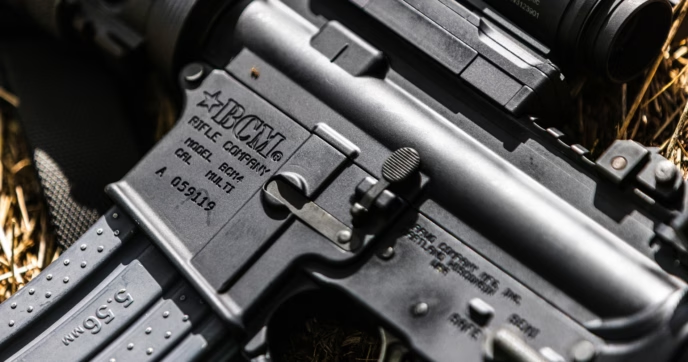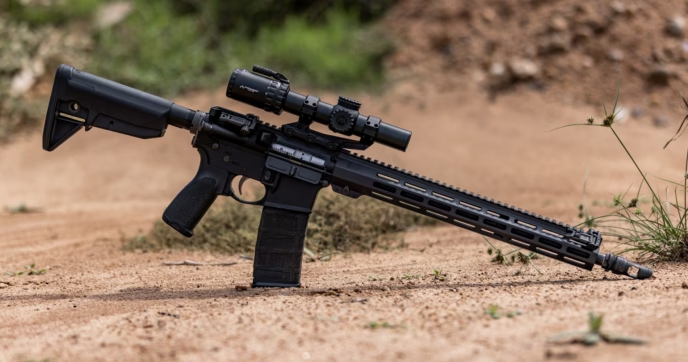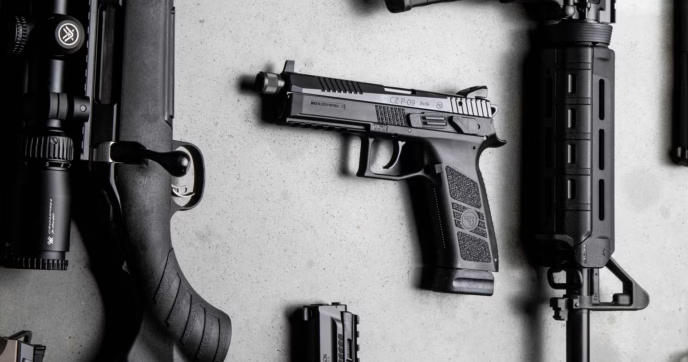If you’ve ever read any of our earlier articles and guides on the AR-15, you’re likely familiar with its deserved reputation as one of the most adaptable rifle platforms around. It’s capable of being outfitted with a myriad of different gear and accessories to make it suitable for a wide array of applications. This adaptability has given enthusiasts the choice to build their rifles instead of buying them.
Still, building an AR-15 requires you to make several decisions, arguably the most critical of which is picking out a lower receiver. AR-15 lower receivers serve as the foundation for your entire rifle build and there are a lot to choose from with multiple brands and lower types to choose from. It can be a challenge to pick just one, but we’re here to help you navigate through each option.

Types of AR-15 Lower Receivers
Much like with an AR’s upper receiver, the lower receiver is available in several configurations. The main categories include stripped and complete, forged and billet, and lastly, ambidextrous and non-ambidextrous.
Stripped and Complete Lowers
Stripped lowers are exactly as their name suggests, a bare lower stripped of all its components. As some of the most affordable options, they’re essentially a blank canvas for your next build. Unless designed to work with proprietary components, these lowers come with no pre-installed parts. For instance, your standard stripped lowers won’t come with anything aside from the lower itself, while ambidextrous lowers, like those from Radian, include their proprietary mag release and bolt catch. To complete these lowers, you’ll need an AR-15 lower parts kit.
In contrast, complete lowers are ready to be paired with an upper out of the box. All the core AR-15 lower parts are all pre-equipped into the receiver, making it perfect for enthusiasts who don’t want to build a rifle piece-by-piece. Keep in mind that these lowers don’t have the same level of customization, but there is a lot to choose from, so there’s something for everyone. That said, if you’re wanting something super specific, you could always upgrade it later, but you’ll need to know how to disassemble an AR-15, and at that point, you might as well opt for a stripped lower.

Forged vs. Billet
Forged lowers are the most common lower type available, made from forging aluminum into shape, resulting in lightweight, durable, and cost-effective choice. Forged lowers are often much lighter than billet ones, and they’re easier to produce, keeping costs down. While a solid option, they’re rather basic in design, lacking premium components such as ambidextrous controls. There are some options like those from Daniel Defense, LMT, and Knight’s Armament that have such features, but they aren’t always sold by themselves and instead come on complete rifles.
Billet lowers, in contrast, are milled into shape from a larger aluminum block. Since they’re milled instead of forged, manufacturers have free rein to include unique designs and components into their lowers. For instance, they can more easily house ambidextrous components, built-in folding stock adapters, and much more. Aesthetically, they also look more appealing than basic forged options in some cases. Compared to forged lowers, billet ones take longer to make. So, depending on the manufacturer and parts included with the lower, they tend to cost much more than forged ones.
Ambi vs. Non-Ambi
Originally, the AR-15 favored right-handed enthusiasts since they’re in the majority, and it made production simpler. However, AR-15 manufacturing processes have advanced to the point where it’s more common to find ambidextrous parts and lower receivers. Ambidextrous lowers provide access to the rifle’s controls on both sides, coming with ambidextrous mag releases, bolt catches, or both. For lefties, they’ll allow you to more easily control the rifle. Either way, they offer an incredible degree of utility, regardless of your dexterity.

Factors to Consider when Choosing a Lower Receiver
Before you set off to buy a new lower for your next AR build, you’ll need to know what to look for in one. As we’ve mentioned, there are lots of options to choose from, and not all lowers are created equal.
Quality and Durability
Like any other rifle part, you’ll want to make sure that your lower is made of high-quality materials. Most of the lowers available today are made of 7075-T6 aluminum, which is both lightweight and durable, making it the go-to choice for most AR parts. Some lowers are made of 6061-T6 aluminum, which is what ARs were historically made of. While not bad, it’s outclassed by 7075, so unless you’re wanting to build a historically accurate clone rifle, we recommend sticking with 7075 for your lower.
Price
Like we said earlier, the price of lower receivers can vary depending on the materials used to make them, their features, and the brand. The most budget-friendly options you’ll find are mil-spec lowers. They’re functionally the same across the board as they’re built to the same universal mil-spec standard. You can usually find these lowers around $50 to upwards of $200. Ambidextrous and billet lowers are more costly options, costing anywhere from around $200 to upwards of $500+, but remember, they offer greater overall utility and are still compatible with almost all lower parts.
Common Pitfalls
If you’re opting for a stripped lower, knowing how to assemble a lower receiver is paramount to your success. In addition to the several small parts that go into a rifle build, there are also specialized tools needed to properly install them. Fortunately, there are several online resources available that go in depth on how to build lowers, often providing step-by-step guides to follow as you build one.
AR-15 Lower Receiver Brands
With the countless number of AR manufacturers around, choosing just one can be a challenge. Below are some well-known manufacturers of lower receivers. Keep in mind that this is just a brief glimpse into the world of AR rifle and parts brands. It’d be impossible to list them all, but the following will help you get started in your search.

Anderson Manufacturing
A well-known brand, Anderson Manufacturing lower receivers are known for blending utility with affordability. As far as stripped lowers go, they offer mil-spec lowers for around $50, but they occasionally have blem lowers that sell for as low as $40. They offer a few different complete lowers as well. Their AM-15 complete lower is outfitted with their lower parts, including mil-spec components and an enhanced trigger group. Similarly, their A4 Carbine lower contains many of the same components but doesn’t have any logo engraving on the side for some aesthetic design. Depending on which lower you look at, their complete options usually run around $200 to $250.
We also feature an Anderson lower in our guide, “Building an AR-15 with an Anderson Lower”. Check it out to get an idea of what’s possible with these lowers.

Aero Precision
There are a lot of Aero Precision lower options available. Their Gen II stripped lower receiver is a solid pick, offering great utility in a standard mil-spec design. They also offer non-mil-spec, forged lowers that maintain the sleeker look of billet ones called the M4E1. It’s available in several configurations that feature different laser engravings and colors, making them some of their most popular lower options. They’re compatible with all core AR components, and they pair particularly well with Aero Precision’s M4E1 upper receivers.
Aero Precision also offers complete variants that use each lower mentioned above. Depending on which one you look at these lowers can either come outfitted with either mil-spec components, or upgraded parts like Magpul furniture, enhanced triggers, and more. Their stripped lowers can range anywhere from around $120 to upwards of $150+, while their complete options are typically found around $275 to as much as $400+, depending on the package.

Sons of Liberty Gun Works
Sons of Liberty Gun Works has made a significant impact on the firearms industry, offering a plethora of high-quality parts. Their mil-spec stripped lower is one of the most popular options they make, serving as a solid foundation for all AR builds. New to their lineup is their billet lower receiver, which was made in collaboration with Forward Controls Design. It’s an ambidextrous lower that’s specifically designed to match FCD’s ambidextrous components.
Compared to the other brands mentioned so far, SOLGW doesn’t offer many complete lower options, although they currently offer one option that uses their mil-spec lower design. It’s outfitted with mil-spec controls, an enhanced trigger group, and upgraded B5 Systems furniture. If you’re looking at a Sons of Liberty Gun Works lower, you can expect to find them around $140 to $300+, while their complete options are offered at $475.

Bravo Company Manufacturing
Bravo Company Manufacturing, or BCM as they’re better known, is an incredibly respected name in the firearm industry. Well known for producing a plethora of rifles, parts, and gear, their lower receivers are sought after for the high-quality components they’re made up of. BCM doesn’t often sell stripped lower receivers, but they do offer quite a few complete options. Each of their lowers are made from forged 7075-T6 aluminum and are available in multiple configurations, coming equipped with various components. They all come with BCM lower parts but are outfitted with different BCM furniture options. For instance, some will come with their Gunfighter Mod 0 stock while others may come with their Mod-1 SOPMOD stock, and so on.
BCM is another premium rifle and parts manufacturer, like SOLGW. As such, their lowers are more expensive than other options. So, depending on the lower you look at, you can expect to find them costing anywhere from around $350 to $450.

Radian Weapons
Radian Weapons is one of the industry’s most renowned producers of rifles and lower receivers. While they don’t offer any complete lower options, their A-DAC lower is perfect for all enthusiasts wanting a top-tier build. The A-DAC (Ambidextrous Dual Action Catch) lower is an ambidextrous lower milled from 7075-T6 aluminum. It has a unique dual action catch design that allows you to easily operate the controls on either side. This makes it a solid choice for left-handed enthusiasts, or those wanting some extra utility out of their rifle. Additionally, it’s offered in multiple colors as well.
This is one of the more premium lower options available. As such, they come with a premium price tag that typically hovers around $515. Still, they can cost less at times when they’re part of our sales.
Conclusion
Choosing the right lower receiver may appear like a simple task, but once you peel back the layers to see what all is available, doing so can be a challenge. It’s crucial to understand what all to look for, as well as what your needs dictate before making any final decisions.
Stripped lowers which offer the greatest degree of customizability but come with the caveat of needing to build it out on your own. Complete lowers limit your ability to pick and choose the parts that go into it but are ready to be paired with an upper out of the box. In addition to these options, you also have the choice to opt for a forged or billet lower, with the possibility to run ambidextrous controls. Either way, there’s a lot to consider before picking one over the other.
At the end of the day, regardless of whether you opt for a complete or stripped lower, so long as it aligns with your needs and preferences, it’s the right one for you. After you’ve completed your build, we recommend getting prepared for upgrades later. Our guide, “Tools for Building a Rifle” highlights some of the crucial tools to have in your kit that are perfect for upgrades and field repairs.





